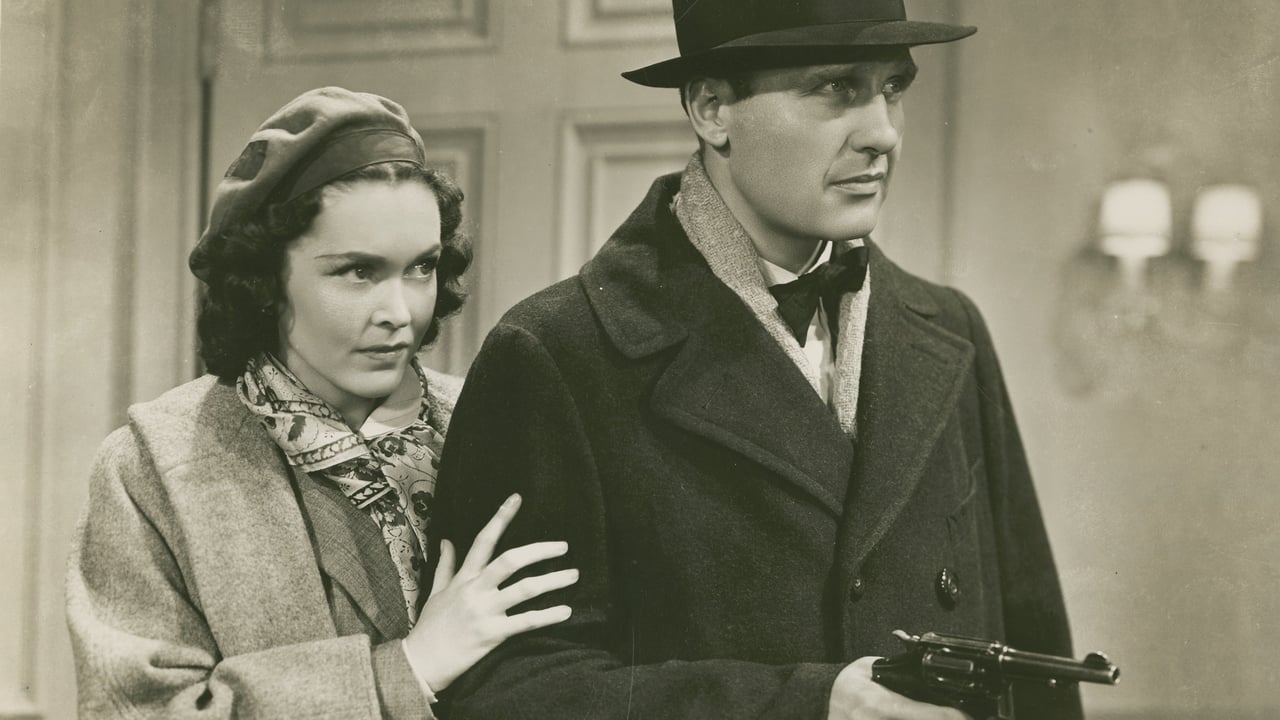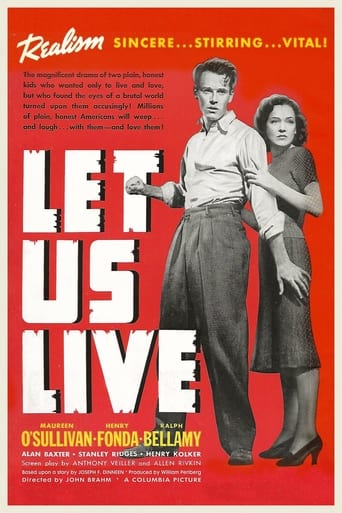

...are all examined here. Knowing that social relevance was important to Fonda throughout his career, and with him being a free agent at the time, I have to wonder if this is how Columbia persuaded such a big talent to star in this project. It's based on a true story that happened in Massachusetts, but in the real story matters don't get quite so dramatic as they did here.Fonda plays cabbie Brick Tennant who is in business for himself, looking forward to marrying his girl, waitress Mary Roberts (Maureen O'Sullivan), and buying a modest house financed by the newly formed FHA. Great time is spent building up what an optimist Brick is and how content he is with his middle class lifestyle. When Brick's down on his luck pal Alan Baxter (Joe Linden) shows up, Brick lets him bunk with him and offers him a job driving the second cab he has just bought.Meanwhile, three criminals wander into town - two of which bear a resemblance to Brick and Alan. First they rob the local police exhibition of all of its weapons and kill the night watchman, then they pull off a daring daytime robbery of a theater and kill someone in that crime too. Since the criminals escaped in a cab, the police decide to pull in every cabbie in the city and alibi them. Brick and Alan are among those who do not have a solid alibi, so they are put in a lineup among the movie patrons who saw the unmasked robbers. At first, nobody speaks up, but then one person says "that's him!" in relation to Brick. Soon they are all saying the same thing. Since Alan was at Brick's apartment alone during the hold-up, and the only person who can alibi Brick is his fiancée, nobody believes them and the wheels of justice grind to their inevitable conclusion. Both Brick and Alan are convicted of murder and sentenced to death.Then a break. Normally a gang of criminals with somebody else convicted of their crimes would in these not so well information-connected times just move their show to someplace far away, assuming they are in the clear here. But although well organized they are apparently not that bright. They pull off a THIRD crime in the exact same town. This time it is a bank robbery, and they shoot it out with a cop in the street killing him. The lucky break - one of the bullets from the shoot out lodges in an apple that Mary buys for Brick to give to him during her visit at the penitentiary. She brings it to police Lieutenant Everett (Ralph Bellamy), and it is identified as a bullet from one of the same guns that were used in the other crimes.Here's the dig. Nobody in authority thinks this is sufficient evidence to at least grant a stay of execution! Their excuse is that the third guy was never caught and he must have the gun. The prosecutor says his job is just to try cases - he's done that. The police say it is their job to collect evidence for open cases - there are none! You'd think that the possibility of two innocent guys being executed would be reason enough to break protocol. You'd be wrong. Only Everett, who sacrifices his career to do so, agrees to help Mary because that lone bullet makes him not so sure justice has been done. There is one more clue uncovered by Brick studying trial transcripts, but I'll let you watch and find out what that is and what happens.Being released during the production code era, this film is rather surprising in its rather subtle indictment of the death penalty and not so subtle criticism of the sometimes robotic behavior of law enforcement, the follies of circumstantial evidence, and the reverse of the "bystander effect" in eyewitness identification. Maybe because Columbia was a small studio and there was no big build up of the film by the studio is the reason the censors did not react.I'd recommend this one. If I have any criticism at all it is that Maureen O'Sullivan gives a rather shrill performance here. Maureen, the audience knows you are telling the truth and that time is running out, please calm down!
... View MoreIt's always good watching Maureen O'Sullivan before she went on to act in the 'Tarzan' films, and it is nice seeing her act alongside of Henry Fonda. It would've been good to see her in a film with Cary Grant. This film has shades of 'The Wrong Man' which Fonda would do seventeen years later with Hitchcock, but 'The Wrong Man' is the better film. Unfortunately, I don't think this is a good film even though it has a good cast. Whereas 'The Wrong Man' was cinematic, this film is not. Fonda didn't need to scream and shout in 'The Wrong Man' because you knew exactly what he was feeling through the music and Robert Burks' cinematography. Here, Fonda has to scream and shout to let you know what he is feeling. That's not cinema. That's theatre.
... View MoreMaureen O'Sullivan and Henry Fonda star in "Let Us Live," a 1939 film also starring Ralph Bellamy. Fonda plays a cab driver engaged to O'Sullivan. He and the friend who is staying with him are arrested for a robbery/murder after being identified by witnesses in a lineup. They are convicted at trial and sentenced to death.It falls to the investigating detective on the case (Bellamy) and O'Sullivan to work to clear the two men. Meanwhile, the two innocent men rot in jail with the clock ticking quickly toward execution.This has to be the fastest trip to the gas chamber in history - we've all read the stories of people languishing on death row for 18 years. It seems like these guys only had a couple of weeks before their execution date.The idea behind this film, though, is solid: The police believe they have the perpetrators, the DA doesn't want anything rocking the boat (even a similar robbery while the two men were in prison), and refuses to stay the executions.I can never get over how much Jane Fonda looks like her dad when I see Fonda in early films. He gives an excellent performance here, that of a bitter, angry man convicted of something he didn't do. I always felt that Fonda as an actor became more internalized as he aged - I prefer the more emotional performances of his. O'Sullivan is energetic and determined as his fiancée, and Bellamy is good in the supporting role.A dark, sobering film about the dangers of rushing to judgment.
... View MoreThis is a dark tale about two likable people. Well, three, if we count Ralph Bellamy: He is tossed at us in medias res and is not convincing as a police lieutenant.The young lovers are Maureen O'Sullivan and Henry Fonda. He drives a cab. She works in a restaurant. He wants them to marry and is planning to buy a cab and maybe a few, to start a fleet.Two decades before he starred in the Hitchcock film of this name, though, he is the wrong man. Not for the adoring (and lovely) O' Sullivan. No, he is erroneously arrested for a robbery -- and falsely identified by a pack of jackals who'd been at the crime scene.One thing I noticed is the response O'Sullivan has when he takes her to look at some nice little homes. She's thrilled and grateful. It's amusing to contrast this to the scornful way the Audrey Totter character acts when Richard Basehart, her unwisely adoring husband in "Tension," takes her to see a little house in the suburbs he's picked out for them.Lucien Ballard was a marvelous cinematographer -- here and always. This movie has the feel of German Expressionism, which includes a Weill-like musical score. But I'm not sure how much of the Expressionism is intended and how much is a matter of budget: For example, there are several scenes in which snow falls. The snow has a highly unreal look. It really LOOKS like soap flakes. And in an early scene when O'Sullivan humors a drunk at the restaurant where she works, the other diners laugh in the oddest way: We're meant to feel they take it in a goodhearted manner. But it sounds for all the world like a laugh track or the audience at a vaudeville show.The change in Fonda is very impressive. I really empathized with his feeling at the start that everything is going his way; that the world is a wonderful place to be. If this were a musical comedy, a song to that effect would have followed. But Fonda didn't make musicals. It's pretty clear that he's going to be disabused of this notion; I've been there too. And he is indeed.
... View More